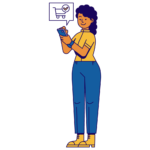If you are the owner of an eCommerce business and wondering how to win customers, read on. This blog post will begin by explaining the buyer journey and strategies to attract, convert, and potentially delight customers. We’ll then look at the best top-of-funnel and middle-of-funnel inbound marketing strategies right now.
Mapping the Buyer Journey
Also called “the purchasing decision-making process”, every business should know their Buyer’s Journey. However, if you run an eCommerce business, this is especially important.
The Buyer’s Journey describes the entire process a customer goes through to make a purchasing decision. There are various stages in this path to purchase. Understanding this journey is crucial for creating effective inbound marketing campaigns.
The Buyer’s Journey is also your marketing funnel. These four key phases in the purchasing decision process also double as four main marketing strategies:
 Awareness Phase = Attract
Awareness Phase = Attract
Shopper becomes aware of their need.
This phase encompasses all the top funnel strategies your company employs to attract new or existing customers. SEO, content marketing and social media marketing are just a few tools you can use to drive more qualified traffic to your website.
 Consideration Phase = Convert
Consideration Phase = Convert
Potential customer evaluates and compares different brands and offerings.
It’s one thing to drive traffic to your site, but you must then get those visitors to take steps towards a purchase. In this phase, you use various marketing strategies such as CTAs, special offers, trials, email marketing, and more.
 Decision Phase = Close
Decision Phase = Close
A visitor becomes a buying customer.
When a visitor is persuaded to buy one or more products, the closing phase begins. In this step, you will mainly use tools such as shopping cart tactics, payment options, and email marketing to finalise the purchase.
 Post Purchase Phase = Loyalty
Post Purchase Phase = Loyalty
A customer becomes a repeat customer.
Converting a visitor may be important, but what happens after the customer makes a purchase determines whether they return. Here your main aim is to delight them with your service. You should be able to process their orders efficiently, deliver quality products, and interact with them via email, surveys or social media in ways that make them brand loyal.
Now that we have explored the key stages of a buyer journey and how it fits in with the marketing funnel, let us look at the best top-of-funnel and middle-of-funnel strategies used by most successful eCommerce businesses.
5 Top of Funnel Tactics for Driving Traffic and Awareness in eCommerce
As mentioned above, your top-of-funnel tactics will help you during the attract phase. In other words, the five strategies below are the most effective ways to attract more people to your online store.
SEO
Search Engine Optimisation or SEO is probably the most common marketing strategy used by eCommerce companies. It is a process that involves creating valuable content and optimising it for search engines like Google so your page will be found in keyword searches.
Nothing is left out of this strategy from keyword research to increasing your domain authority. Organic traffic is usually the best way to bring qualified customers to your website.
Generally, an SEO strategy includes:
- Competitor benchmarking and analysis
- Keyword research and planning
- Meta tags
- On-page optimisation
- Backlinks
- Content development, e.g. blog posts, images, etc.
- Core vitals and page speed improvements
- Website maintenance and security
PPC Advertising
PPC advertising includes paid campaigns that attract clicks so a business can drive traffic to its website. Most eCommerce companies use a combination of search engine-based advertising (eg Google Ads), social media advertising (eg Facebook ads, etc.), in-stream ads (eg YouTube ads), and display advertising (eg banners on other websites).
Social Media Promotion and Influencer Marketing
Social media marketing and influencer marketing are also top-of-funnel strategies that can attract new customers. Platforms like Facebook and Instagram play a huge role in the success of eCommerce businesses.
Therefore, developing a personalised and automated social media strategy is a must. At the same time, many businesses hire niche influencers to promote their products via their own social media channels.
Online PR
PR is a smart inbound strategy that lets you quickly spread the word about your eCommerce store. Online PR includes multiple tools such as online press releases, blogger outreach, niche interviews, guest appearances in videos and podcasts and more. When crafted correctly, an inbound online PR strategy will provide one of the best ROIs (Return on Investment).
Social and Search Shopping Campaigns
Social shopping and search shopping are two popular ways to promote online products. In social commerce, businesses sell their products directly from one or more social media platforms. On the flip side, search shopping leverages the power of search engines, such as Google, and is a fantastic extension to SEO.
4 Middle Funnel Marketing Tactics for eCommerce Businesses
As your customers move further along the buying decision-making process, you’ll need middle-of-funnel marketing tactics. In this phase, you can aim at remarketing, building trust and driving purchasing decisions.
Live Chat
Almost every successful eCommerce company makes it easy and immediate for customers to contact customer service via live chat and/or chatbots. But the truth is that live chat is more than just a customer support function. It can help businesses build trust with their customers and focus on solving their problems quickly and personally. Also, Q&A systems and AI-driven chatbots allow businesses to save time by automating the live chat process.
Upsells and Cross-Sells
Free shipping, countdown messages, CTAs and the like can help you convert more customers. But if you’re looking for a strategy to help increase your average customer value or customer lifetime value, you need cross-sells and up-sells. These tactics are tailored toward altering the buyer’s decisions via add-ons. Giving your customers the motivation to order more of your products is a very smart way to increase your revenue.
Retargeting Ads
Retargeting allows eCommerce companies to advertise to people who have already visited their websites.
Let us say a person visited your store, saved some of your products, and abandoned their cart before completing the purchase. With retargeting ads, you can remind them about the products they left behind and convince them to complete their purchase.
Retargeting ads also mean you can keep your brand top of mind with customers that have purchased from your store before.
Email Marketing
Email marketing is one of the most effective marketing strategies in eCommerce. It includes email list building (email subscribers), email automation and email marketing campaigns.
We have already mentioned retargeting ads for abandoned carts, but email marketing may be even more effective at getting customers back to complete a purchase. And best of all, abandoned cart emails are usually automated making it easy as pie for a business to run these types of campaigns.
From newsletters and welcome emails to storytelling emails and lead nurturing campaigns, email marketing is an endless tactic. This is why, in 2022, email marketing has one of the highest ROIs ($42 for every dollar spent according to this survey).
Bottom Line
The above inbound marketing strategies will help you increase your online sales. But that’s not all. These tofu and mofu tactics will also increase your brand awareness and help you build deeper relationships with your customers.
If you need marketing advice, consider a strategy session with a professional marketing consultant who can create an inbound marketing plan tailored to your business.

